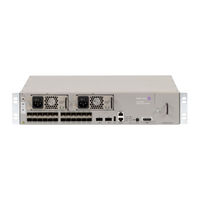Alcatel-Lucent 7210 Sas-R6 Manuals
Manuals and User Guides for Alcatel-Lucent 7210 Sas-R6. We have 1 Alcatel-Lucent 7210 Sas-R6 manual available for free PDF download: Service Manual
Alcatel-Lucent 7210 Sas-R6 Service Manual (948 pages)
Service Access Switch
7210 Sas Series
Brand: Alcatel-Lucent
|
Category: Switch
|
Size: 4 MB
Table of Contents
-
Preface
15 -
-
-
Customers29
-
-
-
-
-
General58
-
-
-
VLL Services
121 -
VLL Services
123-
-
-
-
-
Sdps155
-
-
-
VLL Services188
-
-
VPLS Features237
-
VPLS over MPLS238
-
-
IGMP Snooping240
-
-
Table Management243
-
FIB Size244
-
FIB Size Alarms244
-
MAC Move246
-
-
VPLS Redundancy257
-
-
VLAN Processing270
-
-
BGP AD Overview271
-
SDP Usage276
-
-
Routed VPLS279
-
Interface in a R-VPLS Serviceqos Support for VPLS Saps and IP Interface in a Routed VPLS Service284
-
Table 10284
-
-
-
-
PBB Features573
-
PBB Technology575
-
SAP Support578
-
Pbb B-Vpls578
-
Pbb I-Vpls578
-
-
PBB Qos584
-
PBB ACL Support585
-
-
-
IES Features629
-
IP Interfaces629
-
-
Saps630
-
-
-
VPRN Features697
-
IP Interfaces697
-
IP Interfaces698
-
Saps698
-
Encapsulations698
-
-
Qos Policies699
-
Filter Policies699
-
-
-
-
-
Bgp Commands802
-
Ospf Commands821
-
-
-
Overview928
-
-
Verification931
-
-
-
-
DHCP Principles934
-
DHCP Features936
-
DHCP Snooping937
-
Advertisement
